 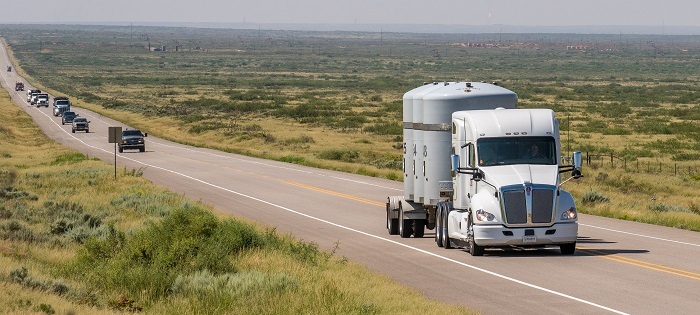 A waste transport delivery truck destined for EM’s Waste Isolation Pilot Plant (WIPP) safely travels down the road. In 2023, WIPP received more than 430 transuranic waste shipments, exceeding an EM 2023 priority to complete and dispose of 400 shipments.
CARLSBAD, N.M. — EM’s Waste Isolation Pilot Plant (WIPP) has accomplished an EM 2023 priority to complete and dispose of 400 transuranic waste shipments while striving to ensure no backlog of shipments from cleanup at the Los Alamos National Laboratory (LANL) site in New Mexico.
“Exceeding 400 transuranic waste shipments to WIPP this year is a positive indication of the cleanup work we’re enabling throughout the nation,” said Mark Bollinger, EM’s Carlsbad Field Office manager. “WIPP’s mission to safely receive and dispose of waste shipments is instrumental to cleanup efforts at Los Alamos and other waste-generating sites, and we safely exceeded our goal at WIPP in 2023.”
 Located 26 miles southeast of Carlsbad, WIPP permanently isolates defense-generated transuranic waste 2,150 feet underground in an ancient salt formation. The facility has been disposing of transuranic waste since 1999.
In early 2023, Salado Isolation Mining Contractors (SIMCO) became the management and operations prime contractor at WIPP overseeing a workforce of nearly 1,500.
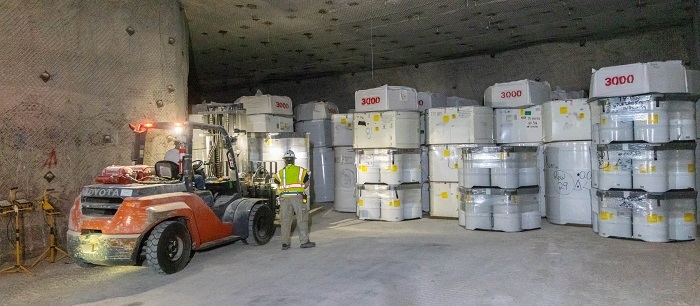 Workers with Salado Isolation Mining Contractors (SIMCO) safely emplace transuranic waste-filled containers inside the Waste Isolation Pilot Plant's (WIPP) deep underground salt repository. In early 2023, SIMCO became the management and operations prime contractor at WIPP.
In October, WIPP received its 400th shipment of the year and SIMCO continued steady waste shipments from generator sites, working especially closely with LANL to ship available waste with no delays. Generator sites are located throughout the U.S., including LANL, Idaho National Laboratory and the Savannah River Site in South Carolina.
“I’m especially proud of everyone embodying the core values of safety, quality and productivity as we characterized, packed, shipped, received and emplaced each waste container this year,” said Tammy Hobbes, a SIMCO vice president and the WIPP Operations and National TRU Program manager. TRU stands for transuranic.
-Contributor: Maelene Soto
 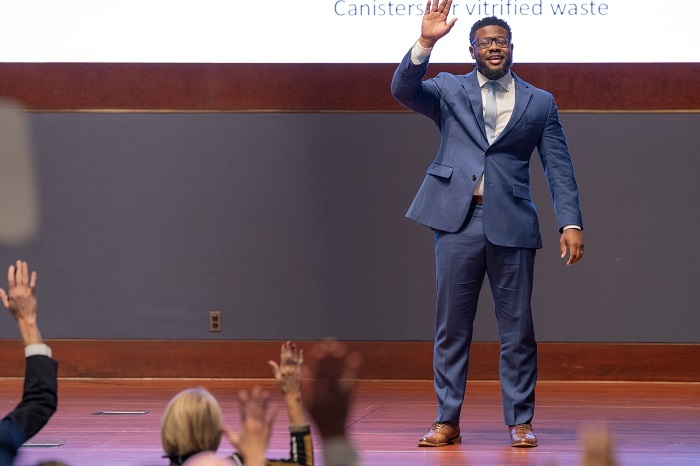 Savannah River National Laboratory Researcher Sean Noble is pictured at the National Lab Research SLAM held recently in Washington, D.C.
WASHINGTON, D.C. — Sean Noble, a researcher with EM’s Savannah River National Laboratory (SRNL), took first place in the environmental resilience category at the inaugural National Lab Research SLAM held recently in Washington, D.C.
“The ability to make our science relatable to all people is key to being successful scientists and to our ability to attract the next generation of researchers to our national laboratories,” SRNL Director Vahid Majidi said. “I’m proud of Sean’s work at SRNL and his performance at the Research SLAM.”
The event featured collaboration among 17 DOE national labs and highlighted DOE research programs. The event also educated policymakers and their staff about the key role the national labs play in the nation’s innovation ecosystem and their impact on the nation.
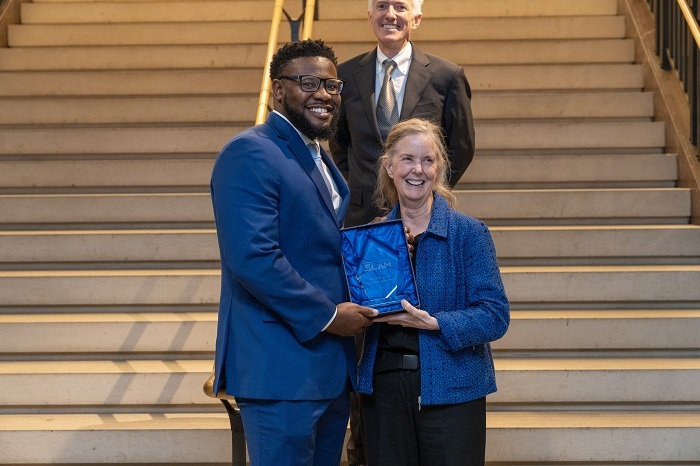 Savannah River National Laboratory Researcher Sean Noble, left, and Sue Clark, the laboratory’s deputy director.
Noble and 16 others presented compelling three-minute presentations about their research in lay person language. Noble’s presentation explained how his research in advanced computer modeling increased safety and productivity while reducing costs associated with mixing and transporting liquid waste.
Speaking about his experience, Noble said he learned how to compose and talk in a way that's more compelling than he had known.
“I would highly recommend this experience to national laboratory colleagues because your comfort zone is stretched a bit, but you learn a lot and you have a good time,” said Noble.
Sponsored by the House Science and National Labs Caucus and the Senate National Labs Caucus, the Research SLAM highlights the importance of effective science communication, especially while communicating with the general public. The event offers career development opportunities for participants and provides visibility into scientific disciplines and research. Participating in the SLAM also promotes cross-discipline collaboration and networking opportunities with other national labs.
-Contributor: Kendall Carter
 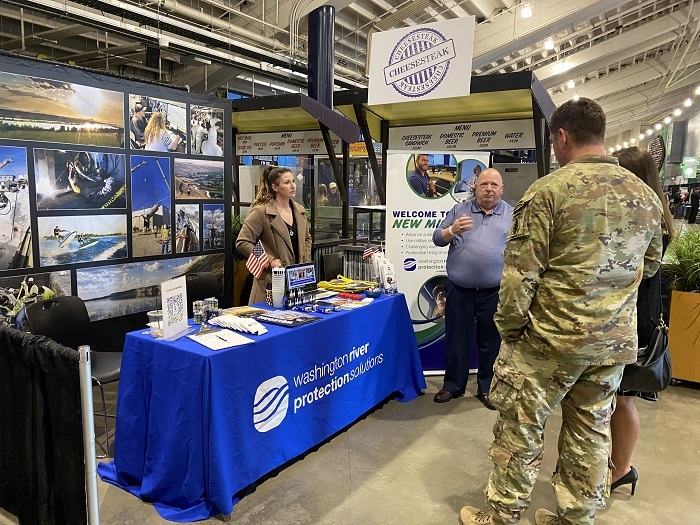 EM and its Hanford Site contractors like Washington River Protection Solutions actively recruit service members and people with disabilities as part of multi-faceted programs to promote diversity in the workplace.
RICHLAND, Wash. — EM Office of River Protection contractor Washington River Protection Solutions (WRPS) has earned state and local accolades for its commitment to support veterans.
The Public Employer of the Year award, presented by the Washington Governor’s Committee on Disability Issues & Employment, commended WRPS for its initiatives in recruiting, hiring and retaining employees with disabilities. About 10% of WRPS employees self-report having a disability. The recognition aligns with the company’s broader inclusive strategy, which was recognized in July with a diversity award from the Tri-City Regional Chamber of Commerce.
“We have an important mission to clean up the Hanford Site, and we can provide our workforce with all the tools they need to be successful,” said Pamela Zimmerman, Office of River Protection and Richland Operations Office chief of staff. “When an employee has a resource that can help them succeed, we should accommodate those resources when it’s safe to do so.”
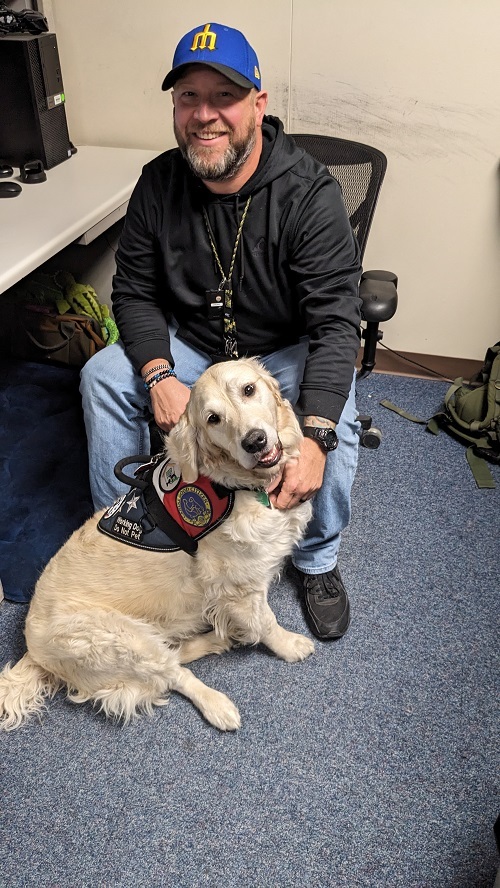 |
|
Service dog Mayday supports nuclear chemical operator Jeff Madsen on the Hanford Site. EM and its contractors make on-the-job accommodations when it is safe to do so, including allowing fully trained service dogs, to attract and support veterans and employees with disabilities. |
 The Tri-City Regional Chamber of Commerce presented contractor Washington River Protection Solutions (WRPS) with a corporate diversity award at the Tri-Cities Diversity Summit in July. Representing WRPS, from left: Jerry Kurtz, Haydee Ramirez, Lisa Bunch, Sylvia Valdez, Celene Chambers, Buddy Cunningham, Amy Hayfield and Jennifer Downing. They are pictured with Jim Arneson, far right, president of the Tri-City Regional Chamber of Commerce.
Hanford nuclear chemical operator Jeff Madsen is a U.S. Army veteran with a combat-related disability. Accommodations allow Madsen to bring his fully trained service dog, Mayday, to work, enhancing his ability to manage his disability.
“No one had tried it before, so I wasn’t sure if I could bring her to work with me,” said Madsen. “WRPS Workforce Resources worked to obtain approval for me to bring Mayday on the Hanford Site because she is a trained service dog through Service Peace Warriors. Everyone has been accepting and supportive and I’m super grateful. My personal and professional life are better because of what she does for me.”
In honor of Veterans Day each year, EM highlights veterans who have transitioned from the military to civilian service in the cleanup program.
Nearly 14% of workers have served in the armed forces. By actively seeking out and supporting veterans, WRPS addresses the unique challenges faced by those transitioning from military to civilian roles.
“Any employer can hire and train military service members, but WRPS actively recruits service members because their soft and hard skills translate to success in this environment,” said Wes Bryan, WRPS president and project manager. “That also gives us the opportunity to overcome some of the challenges service members face while transitioning to the civilian workforce in light of what they faced while making us safer.”
-Contributor: Jenna Kochenauer
 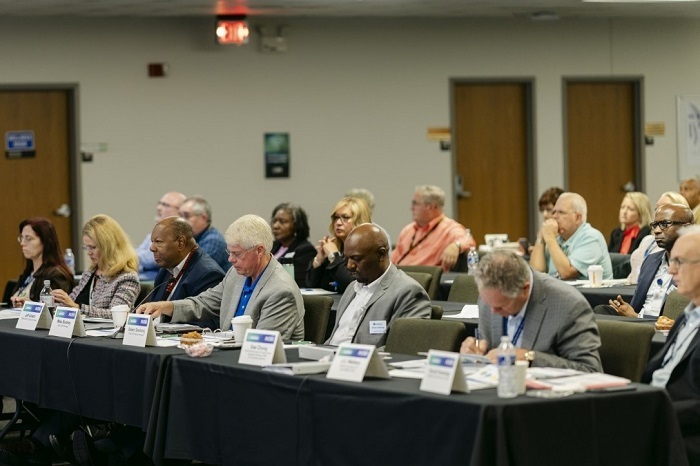 DOE and National Nuclear Security Administration personnel discuss plans for the upcoming Savannah River Site landlord transition during a recent summit.
AIKEN, S.C. — The future of the Savannah River Site (SRS) was the focus of a recent summit on the transition of the site’s landlord responsibilities from EM to the National Nuclear Security Administration (NNSA) next year.
Personnel from DOE and NNSA gathered at the site’s Collaboration Center to discuss plans for the SRS landlord transition set to occur on Oct. 1, 2024, when primary authority, accountability and site stewardship responsibility for SRS is transferred from the DOE-Savannah River Operations Office (SROO) to the NNSA-Savannah River Field Office (SRFO).
Deemed necessary due to the steadily increasing NNSA mission requirements at SRS and the concurrent progression of the EM cleanup mission toward a defined end state, the transition will include transfer of four major areas of responsibility from DOE-SROO to NNSA-SRFO: the Savannah River Nuclear Solutions (SRNS) management and operations contract, including landlord and essential site services; Pro-Force contract; K Area Complex; and environmental permits and agreements.
“We thought it was important to have everyone here so we could meet as many people as possible in person,” DOE-Savannah River (SR) Manager Mike Budney said. “A lot of people have worked very hard on the original transition plan and to put this summit together. They’ve done a tremendous job in getting us to this point, and now we’ve got to carry things through for the next 11 months.”
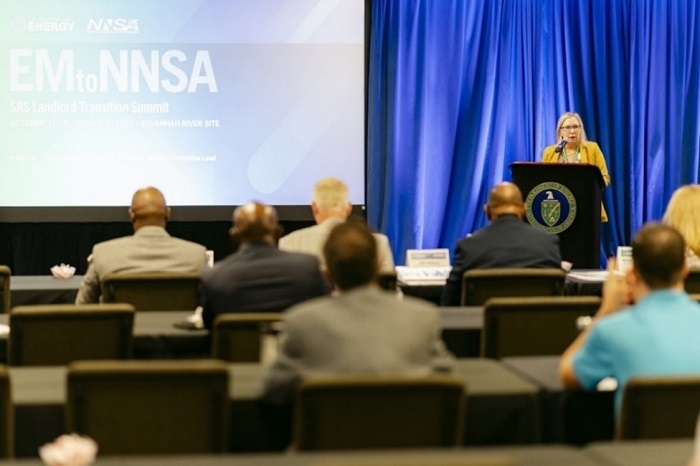 DOE-Savannah River Transition Steering Committee Lead Sherri Robinson gives remarks during a summit focused on the EM-to-National Nuclear Security Administration Savannah River Site landlord transition.
The summit was designed to provide detailed briefings to the NNSA organizations, which will assume SRS landlord function, responsibilities and interfaces. The DOE and NNSA participants also continued to collaborate to accomplish a seamless transition.
“We wanted to ensure that we had as an outcome of this summit some sense of where we are today and what we will end up looking like,” DOE-SR Transition Steering Committee Lead Sherri Robinson said. “We have the ‘as is’ and the ‘to be.’ In order to get to the ‘to be,' we had to start talking collaboratively as a unified group between EM and NNSA. This was the platform we chose to go with.”
At the conclusion of the two-day summit, Robinson said she was pleased with the results.
“I’m very happy with the way everything has turned out. This was a success,” she said. “As some of our SRNS and EM folks have said, they’re ready to launch and feel confident to launch on October 1, 2024. I appreciate everyone’s support.”
NNSA-SRFO Deputy Manager Jeff Allison agreed.
“This summit was excellent. I think this has been a great forum,” he said. “There’s a lot of good work that’s happened so far. There is still a lot of work to be done, but I think we understand what that looks like. Let’s keep communicating and collaborating, and on October 1, we’ll be ready to go.”
-Contributor: Kendall Carter
 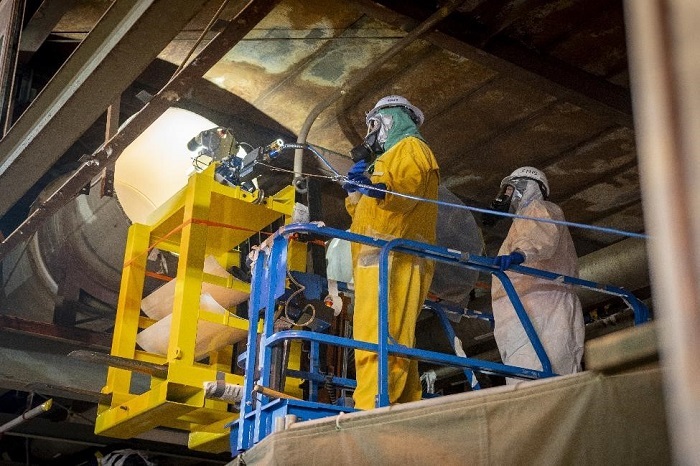 The project team inspecting piping in the C-333 Process Building lift the robotic pipe crawler into place.
PADUCAH, Ky. — Identifying which sections of piping to be removed from the C-333 Process Building at EM’s Paducah Site can be like trying to find a needle in a haystack.
With more than 20 miles of piping, some of which is as large as 42 inches in diameter, the Paducah project team recently deployed a new tool to improve the efficiency of visually inspecting sections of piping: a robotic pipe crawler.
Piping can contain deposits from past gaseous diffusion operations. As a result, some sections of piping have to be removed as crews make progress to prepare the building for future demolition.
Previously, identifying material in this piping required external scanning to pinpoint potential deposit locations for deactivation crews. This effort took many hours using manual cutting tools and additional safety measures to protect workers doing the inspections.
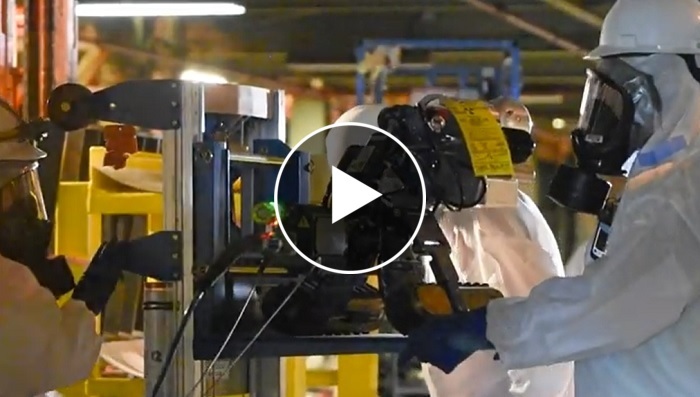 EMTV: Watch a video on the Paducah Site's robotic pipe crawler.
Recently deployed in over 1,000 linear feet of process piping, the robotic pipe crawler reduces the amount of time and effort to visually inspect the piping by using sophisticated detectors and a high resolution camera to identify deposits.
The project team has proven the effectiveness of the robotic pipe crawler using data from external scans in correlation with the data obtained by the machine. As work continues with the robotic pipe crawler for visual inspection of piping, identifying potential deposits is expected to gain efficiency, up to five times faster when compared to manual inspections. It will also provide data necessary to identify more accurate deposit locations and promote worker safety during deactivation where more precise deposit removal activities are needed.
“Innovation is imperative to the success of work done at the Paducah Site,” Portsmouth/Paducah Project Office Manager Joel Bradburne said. “Improving worker safety and reducing the time it takes to inspect piping in the C-333 Process Building will enable DOE to accelerate the facility for demolition and continue the successful cleanup mission at Paducah.”
 The project team inspects piping using the robotic pipe crawler’s high resolution camera in the C-333 Process Building.
The design and process for the robotic pipe crawler came from lessons learned and shared technology, originally developed at the Portsmouth Site. Over the last year, the Paducah team made several enhancements to the robotic pipe crawler and developed methods to ensure it can support deactivation of the C-333 Process Building.
“Portsmouth provided invaluable knowledge from the lessons learned during deactivation and demolition of a process building,” said Myrna Redfield, program manager with Four Rivers Nuclear Partnership, the deactivation and remediation contractor for the Paducah Site. “The Paducah Site took the initiative to incorporate technology developed at Portsmouth into our work in the C-333 Process Building and continues to improve our ability to accomplish complex work with cutting edge technology in the DOE complex.”
-Contributor: Dylan Nichols
 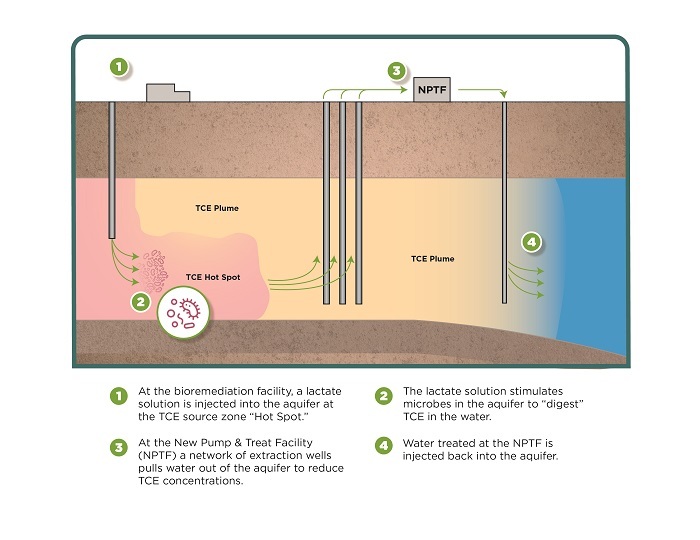
IDAHO FALLS, Idaho — A groundwater treatment well that EM installed two years ago at the Idaho National Laboratory Site is working in parallel with a pump-and-treat system to yield great dividends for the water quality of the underlying Snake River Plain Aquifer.
The new well at the former Test Area North (TAN) facility is used with an existing well to inject a sodium lactate and fatty acid solution directly into the aquifer in a simple, effective treatment method called bioremediation. The new well was needed to further distribute the sodium lactate solution across an area of high trichloroethylene (TCE) concentrations that had not been reached by injections at other wells. TCE was historically used as an industrial solvent at TAN.
The solution is an organic material that stimulates naturally occurring microorganisms to “digest” TCE from the groundwater and effectively “treat” the TCE with the goal of reducing the concentrations of the solvent to meet regulatory standards.
Due to a complex subsurface geology, treated water and the lactate solution move through the aquifer at an average rate of 0.2 to 0.35 feet per day. The future of the facility and the overall effectiveness of the applied treatments will be determined over time. The area of the aquifer directly underneath the TAN facility is not used as a source of drinking water.
TAN was constructed in the 1950s and hosted the Aircraft Nuclear Propulsion program. After 1961, the facility was used for additional nuclear reactor research. During its operation, TAN used a well to inject radioactive and hazardous wastewater directly into the underlying aquifer, a common industrial practice until the 1980s. This practice created a plume in the aquifer that was the subject of a cleanup record of decision by the DOE, U.S. Environmental Protection Agency and state of Idaho in the 1990s. Actions outlined in the record of decision are addressing the plume and improving the water quality of the aquifer.
 |
|
The New Pump and Treat Facility uses a network of extraction wells to move contaminated water from the Snake River Plain Aquifer to the facility, where a technology known as an air stripper removes contaminants by evaporation. |
Since 2002, EM has employed the use of the above-ground treatment unit called the New Pump and Treat Facility (NPTF). This facility uses a network of extraction wells to move water from the aquifer to the facility, where a technology known as an air stripper removes contaminants by evaporation. Treated water that meets regulatory standards is then reinjected into the aquifer. Groundwater that is treated at the NPTF must undergo regular compliance testing and continues to meet the standards required for reinjection into the aquifer.
NPTF treated 8.7 million gallons of TCE-affected groundwater in the fiscal year ending Sept. 30. A total of 865 million gallons of the groundwater have been treated to date.
Groundwater is monitored regularly at the edge of the plume to ensure that concentrations are below regulatory standards and that the plume is not expanding beyond what is allowed in the record of decision.
-Contributor: Carter Harrison
  Savannah River Site operators in plastic suits prepare for the drum venting operations.
AIKEN, S.C. — EM team members at the Savannah River Site (SRS) recently came up with a creative way to ensure the integrity of storage containers holding radioactive material in long-term storage.
The team, which included Savannah River National Laboratory employees, designed and fabricated a tool to pierce cans containing the radioactive material to relieve pressure caused by a buildup of hydrogen gasses. The material is stored in plastic bags and bottles inside the sealed cans, which are held within two 30-gallon drums.
“It is typical for hydrogen gasses, which are flammable, to be generated by decomposition of plastics inside the sealed cans,” said Steve Osteen, an operations specialist with Savannah River Nuclear Solutions, the SRS managing and operating contractor.
The team also created a safe process for venting the cans that includes the use of a containment hut and protective plastic suits for operators.
The team’s goal was to ensure the safety of both drums in storage. As a result of the team’s work, the drums can be safely stored at the site for an estimated 100 additional years if needed.
The two 30-gallon drums containing the radioactive material are stored in the Dry Fuel Storage Area of the site’s L Area Disassembly Basin. They were shipped to SRS from the Idaho Chemical Processing Plant in 2007 and 2008.
SRS had planned to send the material to the site’s HB Line facility for disposition. However, changes in the site’s mission prevented the material from being processed there before the facility went into safe shutdown in 2020. The drums now await a final onsite disposition path.
“The container piercing was executed safely and then the containers were returned to storage,” L Area Facility Manager Neil McIntosh said. “The safe execution of this process was a result of extensive planning, dry runs and mock-ups conducted by the team.”
The team practiced venting mock containers in plastic suits while simulating the confines of the containment hut.
“The evolution was practiced until proficiency was achieved and the team was ready to safely execute the work,” McIntosh said.
-Contributor: Lindsey MonBarren
  A new safety culture assistance visit team, shown here at Oak Ridge, is comprised of individuals from DOE headquarters, various DOE prime contractors, the U.S. Nuclear Regulatory Commission and electric utility company Duke Energy.
OAK RIDGE, Tenn. — The Oak Ridge Office of Environmental Management and cleanup contractor UCOR recently hosted a new safety culture assistance team that will visit DOE worksites to identify strengths and any gaps to excellence.
A 21-person team of individuals from DOE headquarters, various DOE prime contractors, the U.S. Nuclear Regulatory Commission and electric utility company Duke Energy conducted a series of interviews, focus groups and workplace observations to obtain insight into the safety culture at Oak Ridge.
As part of its pilot visit to a DOE worksite, the team shared its observations, including how UCOR employees felt empowered to stop work for perceived safety issues.
“UCOR has a strong safety culture, which is reflected not only in our record but in workforce perceptions measured in various surveys,” said Clint Wolfley, UCOR chief safety officer. “However, one of the keys of having a strong safety culture is knowing that maintaining that culture requires constant focus, dedication, and innovation, so we were thrilled to be the first participant in this process.”
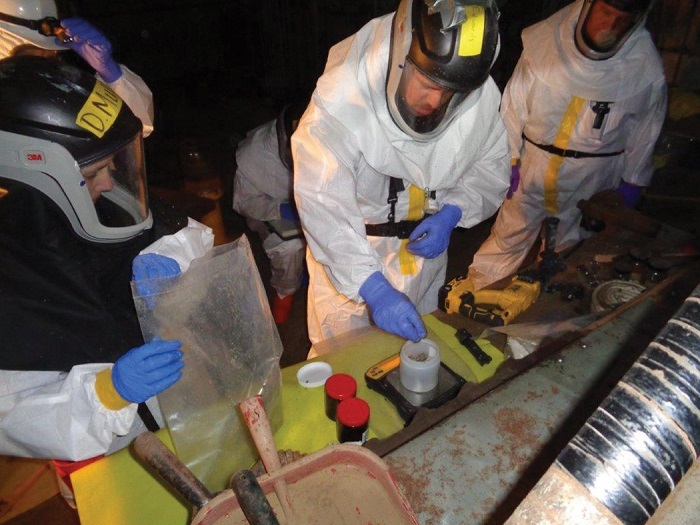 A strong safety culture helps ensure workers in Oak Ridge remain safe as they conduct challenging and complex cleanup work at Oak Ridge National Laboratory and the Y-12 National Security Complex.
The DOE Safety Culture Improvement Panel is working to finalize the safety culture assistance visit process, which provides real-time insight into the status of an organization’s safety culture and safety conscious work environment — specifically focusing on leadership, employee and worker engagement, and organizational learning.
“I continue to be amazed by the amount of learning that took place at the individual, team and organizational level when conducting the assistance visit,” said Julie Goeckner, DOE senior advisor for safety culture. “UCOR’s participation in the pilot helped to validate that the process works.”
A second pilot visit is scheduled at another DOE site early next year, and plans are underway to support several additional requests.
For more information on safety culture assistance visits, email SCIP@hq.doe.gov.
-Contributor: Wayne McKinney
  An aerial view of the Calcine Solids Storage Facility located at the Idaho Nuclear Engineering and Technology Center at the Idaho National Laboratory Site.
IDAHO FALLS, Idaho — EM project managers at the Idaho National Laboratory (INL) Site have released a draft document to the public proposing a final end state for residual granulated calcine waste, piping, tanks and equipment associated with historic spent nuclear fuel reprocessing.
The draft document, “Draft Basis for Section 3116 Determination for Closure of the Calcined Solids Storage Facility at the Idaho National Laboratory,” outlines how residual amounts of calcine, piping, tanks and equipment that may remain after calcine retrieval can be managed as low-level radioactive waste under Section 3116 of the Ronald W. Reagan National Defense Authorization Act for Fiscal Year 2005.
That determination to be made by the Secretary of Energy, in consultation with the U.S. Nuclear Regulatory Commission (NRC), would allow the remaining material to be left in place rather than be sent to a deep geologic repository.
Calcine is a granulated byproduct of liquid radioactive waste that was generated during historic spent nuclear fuel reprocessing runs at the Idaho Nuclear Technology and Engineering Center until 1992. A direct-flame heating source was used to convert the liquid waste into a solid. Radioactive constituents and heavy metals remained in a granular form. The calcine was then transferred by compressed air to tall, stainless steel tanks located inside six concrete silos called bin sets.
EM has been working for several years to develop the draft document to demonstrate the six bin sets at the time of closure meet the Section 3116 criteria. NRC serves in a consultation role and EM will ensure public involvement opportunities throughout the consultation process.
The Section 3116 determination process was used several years ago at the INL Site for the tank farm, which originally stored the liquid radioactive waste in 15 underground, stainless steel tanks.
Following cleaning and grouting of 11 tanks, three remaining tanks store sodium-bearing liquid waste for treatment by the Integrated Waste Treatment Unit, while the final tank has always been empty and is a spare.
EM and NRC held a virtual public meeting in mid-November and a comment period on the draft document remains open until Dec. 11.
-Contributor: Erik Simpson
 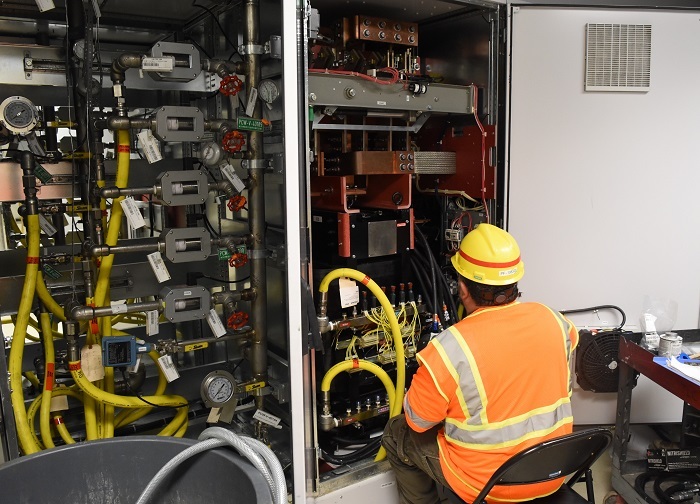 A worker performs maintenance on cooling water hoses inside the power supply cabinet for a 300-ton glass melter at the Waste Treatment and Immobilization Plant on the Hanford Site.
RICHLAND, Wash. — A Hanford Site contractor responsible for designing, building and commissioning the Waste Treatment and Immobilization Plant (WTP) has recognized the collaborative efforts of three of its key suppliers with Supply Chain Excellence Awards.
Bechtel National, Inc. (BNI) honored Hitachi Energy USA, ABB Inc. and Alaska Rubber Group (ARG) for their work in supplying equipment needed for WTP’s successful resumption of the heatup process for the first 300-ton glass melter within the Low-Activity Waste Facility at Hanford.
The initial melter heatup faced a challenge in late 2022 due to electrical issues in the power supply system. The three suppliers supported WTP through the repair process, providing equipment and technical expertise during the analysis, design and troubleshooting phases.
“Hitachi, ABB and ARG made truly vital contributions to the success of Melter 1 heatup this summer,” said Frank Salaman, BNI procurement and subcontracts manager at WTP. “They demonstrated extraordinary performance and commitment to safety, quality, cost, schedule and sustainability on our project. These awards are extremely well deserved.”
Mat Irwin, EM acting assistant manager for the Waste Treatment and Immobilization Plant Project, said suppliers play an essential role in the Hanford cleanup mission.
“Whether providing day-to-day services or supporting a mission critical project like Melter 1 heatup, their impact can be felt across the Hanford Site,” he said.
-Contributor: Tyler Oates
 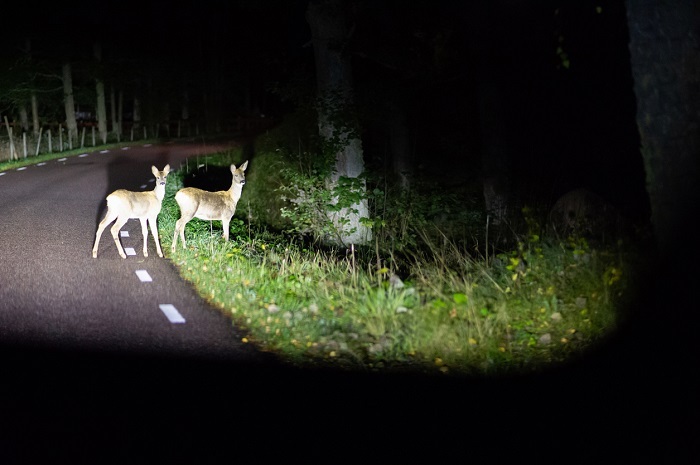 A Savannah River Ecology Laboratory study found, on average, that deer were identified at 297 feet from the vehicle when drivers used high-beam headlights compared to 217 feet with low beams. To place this in perspective, the 80-foot difference in detection distance is equivalent to roughly 5 1/3 car lengths.
AIKEN, S.C. — A recent study conducted at the Savannah River Site (SRS) by scientists and students from the University of Georgia’s Savannah River Ecology Laboratory (SREL) sheds light on the ability of drivers to observe animals and avoid dangerous wildlife-vehicle collisions at night safely.
“It’s the first study of its kind to use wild animals instead of decoys,” said Carson Pakula, SREL graduate student and lead author of the study. “This allows for a more realistic evaluation of a driver’s ability to discern wildlife. The implications from this study are significant because it demonstrates the importance of high-beam headlight usage, driving at safe speeds and limiting the amount of time driving at night.”
The study is one example of how SREL and EM regularly work at SRS to tackle issues of regional and national importance.
“This research demonstrates SREL’s leadership in advancing safety and the environment. We are proud of our 70-plus-year partnership with SREL, further exemplifying SRS’s commitment to safety and the community,” said Angelia Holmes, deputy assistant manager for Infrastructure & Environmental Stewardship at SRS.
To ensure consistency, the research team chose a single-vehicle model, gathered 24 volunteers that reflected typical drivers and selected a realistic driving route that replicated conditions that drivers encounter in the Southeast.
The drives were completed after sunset at SRS. The volunteers navigated a 47-mile circuitous route through the site with a truck equipped with an infrared video camera that could identify animals up to a half mile away. The camera provided a continuous live feed and recorded the footage of all wildlife along the road.
Dangerous encounters
Investigators found that approximately 45% of encounters with deer were dangerous. This means the detection distance was less than required to brake safely. This number significantly increased when the drivers’ speeds climbed and they were tired.
“We were surprised by the decrease in detection distances for deer as drives progressed,” said DeVault, associate director of research at SREL and senior author on the study.
Alarmingly, drivers failed 100% of the time to spot wild pigs with enough time to brake safely.
“Drivers generally spotted pigs at such short distances that if they had moved into the road, drivers might not have been able to brake in time to avoid collisions,” said DeVault.
Headlights matter
Headlights played a dramatic role in recognizing wildlife. On average, deer were identified at 297 feet from the vehicle when drivers used high-beam headlights compared to 217 feet with low beams. Similar increases were seen when using high-beam headlights with coyotes, wild pigs and small mammals like raccoons.
How can you stay safe when driving at night?
Based on the findings of this study, one can stay safe by reducing speed, avoiding long drives at night and using high-beam headlights.
Read more about the study here.
-Contributor: Katrina M. Ford
 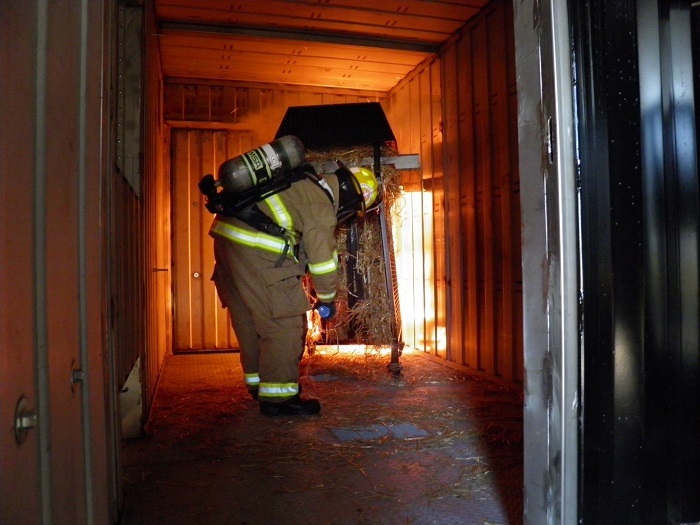 A firefighter instructor ignites straw inside the “burn building” training facility to create heat and smoke during the first live-fire training conducted at the Portsmouth Site.
PIKE COUNTY, Ohio — Firefighters at EM’s Portsmouth Site recently conducted the first live-fire training in a newly constructed training facility.
Known as the “burn building,” the facility will be used several times a year for confined-space rescue training and to refine other firefighting techniques.
Portsmouth Site Lead Jeremy Davis toured the facility earlier this year and provided positive feedback.
“I was impressed with the building and the adaptations that could be made to create a variety of rigorous training scenarios for our firefighters,” Davis said. “I’m looking forward to seeing it in action.”
The event was geared to the site’s fire department training personnel and included several hours of practical training and classroom instruction.
Throughout the training, a team of instructors from Oklahoma demonstrated use of a temperature monitoring system and discussed the building’s features.
One of the instructors was part of the rescue team during the Oklahoma City bombing in 1995; the other led a fire department that responds to more than 3,000 calls per year.
 From left, firefighter Derek Howell; 1st Due Fire Training Trainer Brian Arnold; firefighter Cameron Clouser; Portsmouth Site Fire Department Manager Tony Wheeler; 1st Due Fire Training Trainer Conner Arnold; and fire commanders Rick Mays and Dan Burkitt.
“The trainers are knowledgeable and ready to discuss how to improve the building’s effectiveness,” said Jim McCleery, the emergency services director with Fluor-BWXT Portsmouth (FBP), the site’s decontamination and decommissioning contractor. “No one concluded the training disappointed.”
The previous training facility had become compromised and no longer met National Fire Protection Association standards for live-fire training.
The new facility’s location offers convenience for scheduling and allows the department to assist with training for local departments and new firefighters.
“The trainers offered suggestions on how we could adjust features in the building as well as methods on how to make each training scenario a little bit different,” FBP Fire Department Manager Tony Wheeler said.
-Contributors: Jim McCleery, Michelle Teeters
  DOE-Savannah River Manager Mike Budney, left, and Savannah River Mission Completion President and Program Manager Dave Olson sign the Savannah River Site Liquid Waste Program Partnering Agreement in April 2022.
AIKEN, S.C. — Diligent and collaborative partnering efforts between EM and contractor Savannah River Mission Completion (SRMC) have enabled significant progress in the liquid waste mission at Savannah River Site (SRS).
SRMC was awarded the end-state Savannah River Integrated Mission Completion Contract just over two years ago.
Following the contract transition and implementation periods, a one-year task order was awarded for continued liquid waste operations, along with additional task orders for Saltstone Disposal Unit (SDU) construction and other work. SDUs are mega-size disposal units that receive decontaminated material for disposal. A task order defines a project's scope, cost and schedule.
 The Savannah River Site liquid waste system.
In April 2022, the DOE-Savannah River and SRMC leadership teams established the SRS Liquid Waste Program Partnering Agreement that builds upon the collaborative working relationship between the two entities.
The partnering agreement includes the mission and objectives for the SRS liquid waste team to work together to treat and dispose of radioactive waste and operationally close both liquid waste tank farms at SRS by 2037 in a manner that safely, efficiently, and effectively protects workers, the public, and the environment. A tank farm is a grouping of underground waste tanks.
The successful and concerted efforts during the initial one-year task order for liquid waste operations, along with the Salt Waste Processing Facility operations and other work, set the stage for the award in September 2023 of two long-term, eight-year task orders.
One of the task orders, valued at $7.3 billion, is for potentially processing more than 60 million gallons of salt waste. The other task order, valued at $1 billion, is for tank and ancillary facilities closure, including the operational closure of up to 12 tanks.
The task order awards will enable SRMC to continue making substantive progress toward the ultimate goal of completing the SRS liquid waste mission under the end-state contract by 2037.
  Legacy waste containers leave the West Valley Demonstration Project en route to an offsite disposal facility. The ongoing demolition of the site’s Main Plant Process Building can be seen in the background.
WEST VALLEY, N.Y. — EM and contractor CH2M HILL BWXT West Valley (CHBWV) have safely disposed of several containers and boxes of legacy waste and equipment from the West Valley Demonstration Project cleanup.
“This accomplishment reduces stored waste at the site and prepares us for the continuation of our cleanup mission,” EM West Valley Project Management Director and Main Plant Federal Project Director Stephen Bousquet said. “By performing this work now, we can use our highly skilled workforce to further reduce legacy risks.”
Crews moved four of the waste packages into containers approved by the U.S. Department of Transportation (DOT) that have steel-reinforced concrete shielding. They sent them by truck to a rail yard in Lockport, New York, where they were loaded onto rail cars and shipped for safe disposal. Each container held water filtering materials from the former Fuel Receiving and Storage facility at the site.
CHBWV workers also successfully shipped two containers that held vessels from a cell of the Main Plant Process Building to an offsite disposal facility. They also shipped seven waste boxes offsite for disposal that contained storage racks and other oversized equipment used during past operations at the site.
“Our team continues to use their combined knowledge to safely and deliberately complete high risk work activities,” CHBWV Waste and Site Operations Manager Peggy Loop said. “I’m proud of their efforts, accomplishments and the work they continue to do on this project.”
-Contributor: Joseph Pillittere
 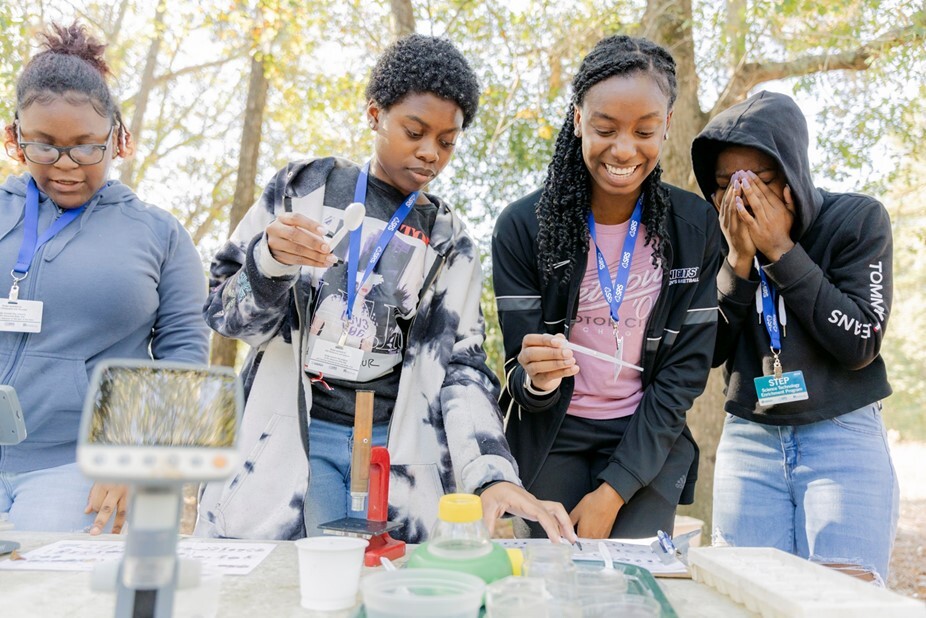 Richmond County Technical Career Magnet School students use microscopes and other tools to identify aquatic specimens caught in a nearby pond.
Educating Future Generations with Environmental Enrichment Activities
AIKEN, S.C. — Seniors from Richmond County Technical Career Magnet (RCTCM) School in Augusta, Georgia, recently experienced a unique hands-on field trip through the Savannah River Site (SRS) forests to practice environmental stewardship and learn about a variety of career opportunities.
The Science and Technology Enrichment Program (STEP) at SRS is a longstanding, cooperative effort between SRS management and operations contractor Savannah River Nuclear Solutions (SRNS) and Ruth Patrick Science Education Center (RPSEC). Lessons correlate to academic curriculum for grades three through 12 and use real-world investigations to spark interest in science, technology, engineering, and math (STEM).
“The Savannah River Site has so much to offer with miles of trails, ponds and a variety of protected wildlife,” said Taylor Rice, SRNS education outreach specialist. “It is so important for local students to experience this opportunity to spark their interest in STEM.”
The advanced placement environmental science class from RCTCM completed a watershed activity to address human impact on healthy ecosystems and studied the biotic factors of healthy ponds and macroinvertebrates. Macroinvertebrates are insects in their nymph and larval stages, such as snails and worms.
 A senior from Richmond County Technical Career Magnet School wades through a nearby pond, capturing macroinvertebrates with a net.
“In a world where electronics and virtual instruction rule, it is important for our future generation to get outside and experience hands-on learning activities from industry leaders,” said RCTCM science department chair Nathalie Pace. “Many of my students are still deciding what they want to be or what career path to follow, and this experience is very impactful on their decision.”
Pace finds the program to be like no other, with many students expressing thanks for the exposure to new opportunities.
“Field trips are incredibly beneficial and special to students that do not always have the means or transportation to connect with their communities outside of school,” Pace said. “As a science educator, I will continue to work with SRNS and RPSEC to make this happen for my students.”
STEP continues to create remarkable experiences for students visiting the site, which is home to many rare and endangered species. Students delve into topics such as preserving the nesting habitat of the endangered red-cockaded woodpecker, constructing watersheds, analyzing pollution and identifying freshwater macroinvertebrates in ponds and streams.
“We always aim to build excitement and curiosity around the environment and STEM careers through these activities,” said Beth Eberhard, the center’s student program specialist. “After working for this program for eight years, I truly enjoy seeing the excitement on students’ faces as they get outside, explore and make unique observations.
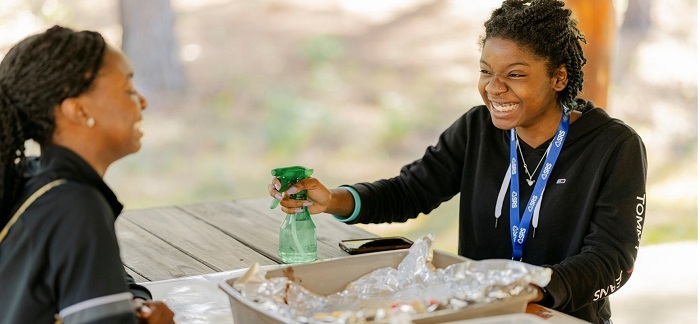 During the Savannah River Site Science and Technology Enrichment Program field trip, two Richmond County Technical Career Magnet School students build a watershed model to see how humans impact the water supply and how to mitigate harmful actions.
RCTCM senior Monica Burns would recommend this program to other students who are interested in SRS.
“The watershed activity impacted the way I viewed my daily actions and helped me understand the importance of being conscious and conservative to protect the environments that surround me every day,” said Burns.
SRS will continue to grow its 40-year partnership with RPSEC by bringing STEP field trips to local students.
For more information about STEP field trips, contact Rice.
-Contributor: Mackenzie McNabb
|



